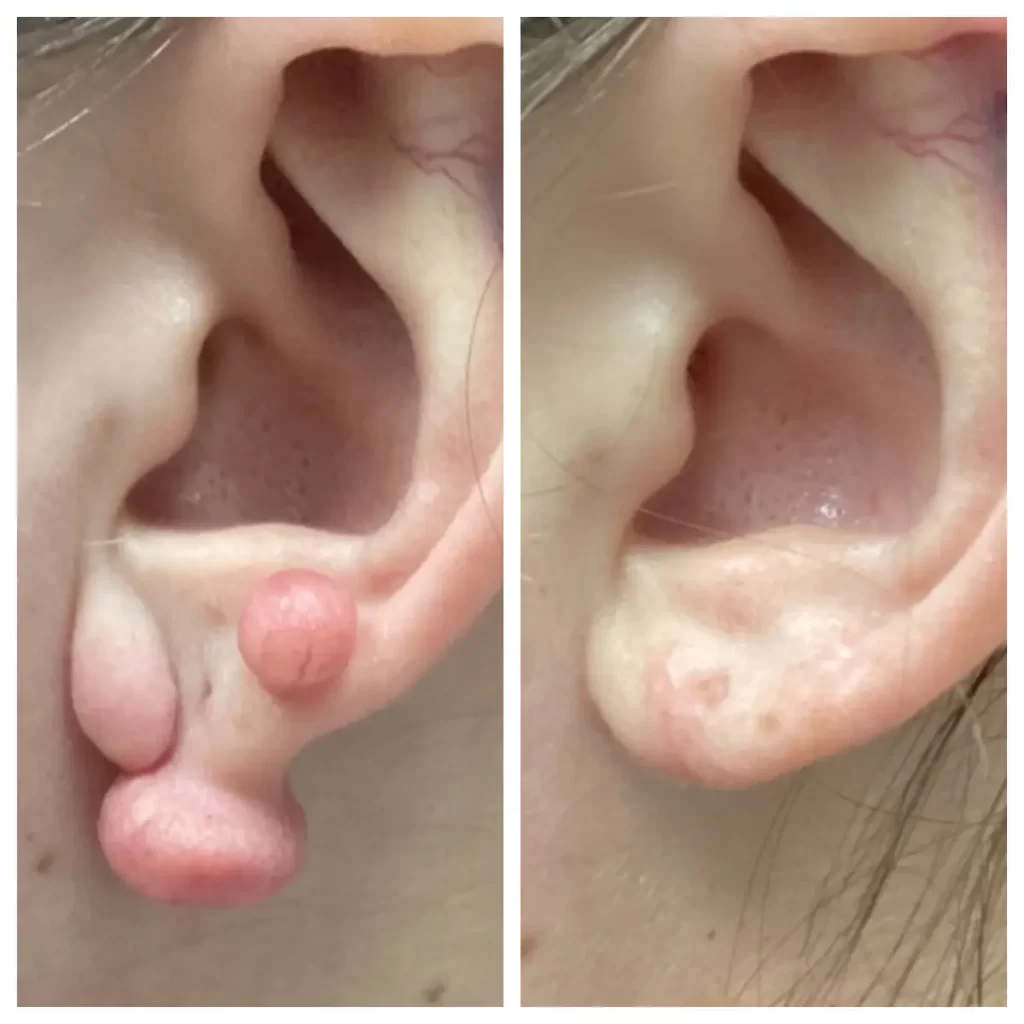Keloids
Learn about keloids: causes, prevention, and treatments. Understand the solutions for managing these challenging scars.
Example Of A Keloid Earring Scar

What Are Keloids?
Keloids are overgrowths of scar tissue that develop where skin has healed after an injury. Unlike normal scars, keloids extend beyond the original injury site and may continue to grow over time. They can appear anywhere on the body but are most common on the chest, shoulders, earlobes, and cheeks.
Causes and Risk Factors
The exact cause of keloids isn’t fully understood, but several factors contribute to their formation:
- Genetics: There is a strong genetic component to keloid formation. You are more likely to develop keloids if a close family member has keloids.
- Skin Type: People with darker skin tones, mainly African, Hispanic, or Asian descent, are more prone to developing keloids.
- Age: Keloids are more likely to develop in individuals between 10 and 30.
- Location of Injury: Keloids are more common in areas with high skin tension, such as the chest, back, shoulders, and earlobes.
- Type of Skin Injury: Keloids can form after various skin injuries, including acne, piercings, surgical incisions, burns, vaccinations, or even minor cuts and insect bites.
Symptoms and Characteristics
Keloids typically:
- Raised and Firm: Keloids are elevated above the skin and feel firm to the touch.
- Growth Beyond the Wound: Unlike hypertrophic scars, which remain confined to the injury site, keloids extend beyond the original wound.
- Shiny Appearance: The surface of a keloid may appear shiny and smooth.
- Color Variations: Keloids can be pink, red, purple, or darker than the surrounding skin.
- Itching and Discomfort: Keloids may cause itching, tenderness, or discomfort, primarily if they are located in areas where the skin stretches or moves frequently.
Prevention Strategies
While not all keloids can be prevented, there are steps you can take to reduce your risk:
- Avoid unnecessary skin trauma, such as piercings or tattoos, especially if you’re prone to keloids
- Proper wound care to minimize scarring
- Use of silicone sheets or gels on fresh wounds
- Pressure therapy for healing wounds in high-risk areas
Treatment Options
At St. Louis Dermatology & Cosmetics, we offer several treatment options for keloids:
- Corticosteroid Injections: These can help flatten the keloid and reduce symptoms.
- Cryotherapy: Freezing the keloid with liquid nitrogen may help reduce its size.
- Laser Therapy: Certain lasers can improve the appearance of keloids and reduce redness.
- Surgical Removal: Sometimes, the keloid may be surgically excised. However, this is often combined with other treatments to prevent recurrence.
- Radiation Therapy: Sometimes used with surgery for severe cases.
- Topical Treatments: Silicone sheets, gels, or certain ointments may help manage keloids.
- Pressure Therapy: Applying constant pressure to the area can help prevent keloid formation or recurrence.
It’s important to note that keloids can be challenging to treat and may recur even after successful treatment. A combination of therapies is often the most effective approach.
When to Seek Professional Help
If you notice an unusual growth of scar tissue or are concerned about keloid formation, it’s crucial to consult a dermatologist. Early intervention can lead to better outcomes.
At St. Louis Dermatology & Cosmetics, our experienced team of dermatologists can provide personalized treatment plans to address your specific needs. We understand that keloids can be both a cosmetic concern and a source of discomfort, and we’re here to help you achieve the best possible results.
Don’t let keloids affect your confidence or quality of life. Contact St. Louis Dermatology & Cosmetics today to schedule a consultation and explore your treatment options. Together, we can develop a strategy to manage your keloids effectively and help you feel more comfortable in your skin.
GET IN TOUCH

